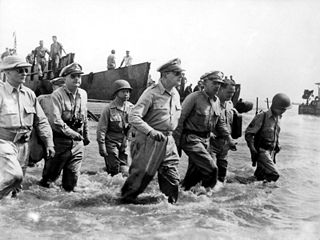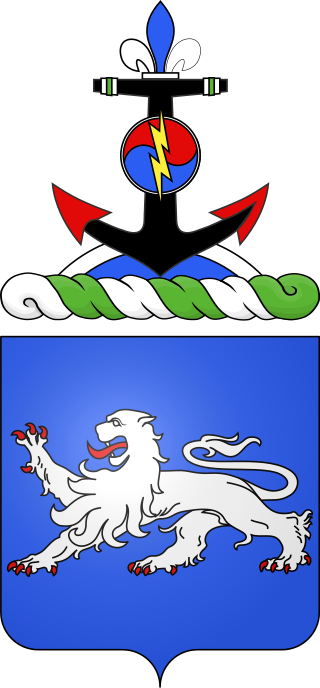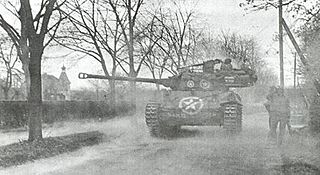
The Battle of Peleliu, codenamed Operation Stalemate II by the US military, was fought between the United States and Japan during the Mariana and Palau Islands campaign of World War II, from 15 September to 27 November 1944, on the island of Peleliu.

The Battle of Leyte in the Pacific campaign of World War II was the amphibious invasion of the island of Leyte in the Philippines by American forces and Filipino guerrillas under the overall command of General Douglas MacArthur, who fought against the Imperial Japanese Army in the Philippines led by General Tomoyuki Yamashita. The operation, codenamed King Two, launched the Philippines campaign of 1944–45 for the recapture and liberation of the entire Philippine Archipelago and to end almost three years of Japanese occupation.

The 14th Armored Division was an armored division of the United States Army assigned to the Seventh Army of the Sixth Army Group during World War II. It remains on the permanent roll of the Regular Army as an inactive division, and is eligible for reactivation. The division is officially nicknamed the "Liberators".

The 24th Infantry Division was an infantry division of the United States Army that was inactivated in October 1996. Formed during World War II from the disbanding Hawaiian Division, the division saw action throughout the Pacific theater, first fighting in New Guinea before landing on the Philippine islands of Leyte and Luzon, driving Japanese forces from them. Following the end of the war, the division participated in occupation duties in Japan, and was the first division to respond at the outbreak of the Korean War. For the first 18 months of the war, the division was heavily engaged on the front lines with North Korean and Chinese forces, suffering over 10,000 casualties. It was withdrawn from the front lines to the reserve force for the remainder of the war after the second battle for Wonju, but returned to Korea for patrol duty at the end of major combat operations.

The 9th Division was a division of the Australian Army that served during World War II. It was the fourth division raised for the Second Australian Imperial Force. The distinctions of the division include it being:

The 77th Sustainment Brigade is a unit of the United States Army that inherited the lineage of the 77th Infantry Division, which served in World War I and World War II. Its headquarters has been at Fort Dix, New Jersey, since its predecessor command, the 77th Regional Readiness Command, was disestablished in 2008 from Fort Totten in Bayside, Queens, New York. Soldiers from the 77th have served in most major conflicts and contingency operations involving the US since World War II.

The 96th Infantry Division was an infantry division (military) of the United States Army. It was formed in 1918 and served in World War I and in the Pacific War during World War II. It was reformed after the war and was part of the United States Army Reserve until 1965.

The Oxfordshire and Buckinghamshire Light Infantry was a light infantry regiment of the British Army that existed from 1881 until 1958, serving in the Second Boer War, World War I and World War II.

The 5th Marine Division was a United States Marine Corps ground combat division which was activated on 11 November 1943 at Camp Pendleton, California during World War II. The 5th Division saw its first combat action during the Battle of Iwo Jima in 1945 where it sustained the highest number of casualties of the three Marine divisions of the V Amphibious Corps. The 5th Division was to be part of the planned invasion of the Japan homeland before Japan surrendered. Assault troops of the 5th Division were included in the Presidential Unit Citation awarded to the V Amphibious Corps for extraordinary heroism on Iwo Jima from 19 to 28 February 1945. The 5th Division was deactivated on 5 February 1946.
The 741st Tank Battalion was an independent tank battalion that participated in the European Theater of Operations with the United States Army in World War II. The battalion participated in combat operations throughout northern Europe until V-E Day. It was one of five tank battalions that landed in Normandy on D-Day. It landed on Omaha Beach supporting the 1st Infantry Division, but was attached to 2d Infantry Division on 15 June 1944, which it supported for most of the remainder of the war. The battalion played a key role in blunting the northern flank of the German attack during the Battle of the Bulge in December 1944. The 741st Tank Battalion advanced as far as Plzeň, Czechoslovakia by the end of the war.

The Hampshire Regiment was a line infantry regiment of the British Army, created as part of the Childers Reforms in 1881 by the amalgamation of the 37th Regiment of Foot and the 67th Regiment of Foot. The regiment existed continuously for 111 years and served in the Second Boer War, World War I and World War II. An Army Order of the 28 November 1946 stated, due to distinguished service in the Second World War, the regiment would be re-titled as the Royal Hampshire Regiment.

The 23rd Armoured Brigade, originally formed as the 23rd Army Tank Brigade, was an armoured brigade of the British Army that saw service during the Second World War. The brigade was a 2nd Line Territorial Army (TA) formation. It was reorganised and renamed the 23rd Armoured Brigade, when it was assigned to the 8th Armoured Division, although it never operated under command of the division.

The 184th Infantry Regiment is an infantry regiment of the United States Army consisting of soldiers from the California Army National Guard. Only the regiment's 1st Battalion remains an active military unit. The battalion supports state and federal missions in the State of California, United States of America and at overseas locations. The 184th Infantry Regiment can trace its lineage to the mid-19th century.

The Battle of Labuan was an engagement fought between Allied and Imperial Japanese forces on the island of Labuan off Borneo during June 1945. It formed part of the Australian invasion of North Borneo, and was initiated by the Allied forces as part of a plan to capture the Brunei Bay area and develop it into a base to support future offensives.

The 68th Armor Regiment is an armored regiment of the United States Army. It was first activated in 1933 in the Regular Army as the 68th Infantry Regiment.
The 34th Infantry Regiment is a Regular Army infantry regiment of the United States Army. It saw combat in World War I, in the Pacific Theater of Operations in World War II, and was the first full American regiment deployed in combat in the Korean War. The 1st and 3rd Battalions of the 34th are now basic training formations attached to the 165th Infantry Brigade at Fort Jackson, South Carolina.
The 161st Infantry Regiment is an infantry regiment of the United States Army and the Washington Army National Guard. It is the oldest unit in the Washington Army National Guard, tracing its lineage to the separate infantry companies of the Territorial Militia. Its 1st Battalion is a Stryker-based element of the 81st Stryker Brigade Combat Team consisting of three Stryker infantry companies and one headquarters company, with its headquarters in Spokane, Washington.

The 743rd Tank Battalion was a US Army independent tank battalion in the European theater during World War II. It was one of five tank battalions which took part in the initial landings of the Invasion of Normandy. The battalion participated in combat operations throughout northern Europe until the end of the war in Europe. It was inactivated on 27 November 1945.

The 824th Tank Destroyer Battalion was a tank destroyer battalion of the United States Army active during the Second World War. It saw service during 1944–45 in the European Theater of Operations, primarily attached to the 100th Infantry Division in an infantry support role. After fighting through France and southern Germany, the battalion ended the war in Austria.

The 106th Infantry Regiment was the designation of two separate New York Army National Guard regiments. The first is currently active as the 106th Regiment (Regional Training Institute), and the second is active as a result of consolidation with the 101st Cavalry Regiment.
















